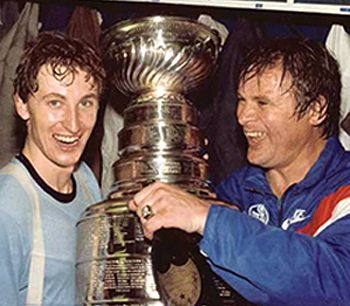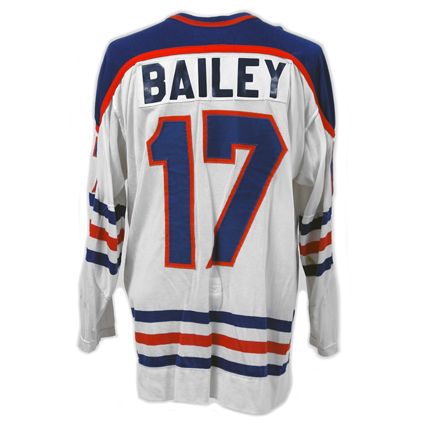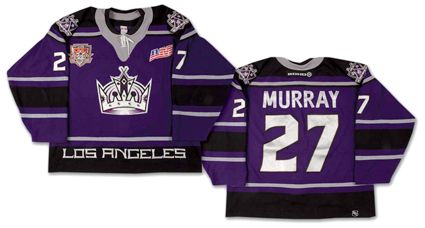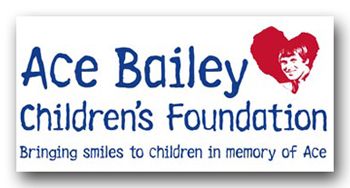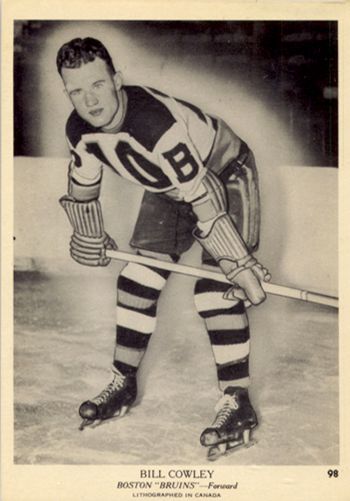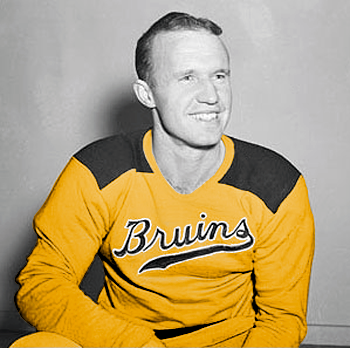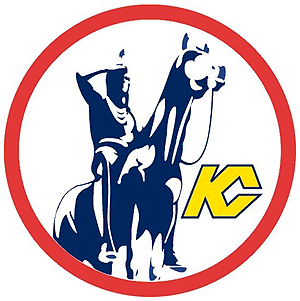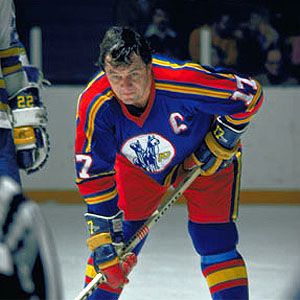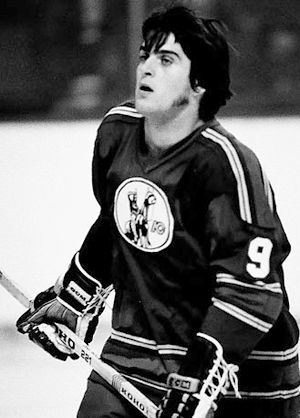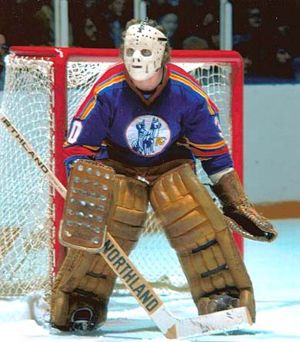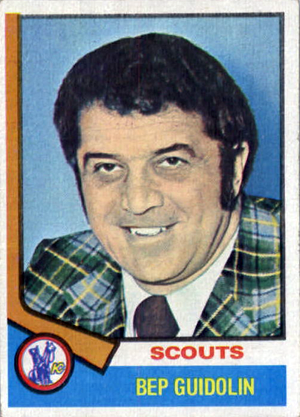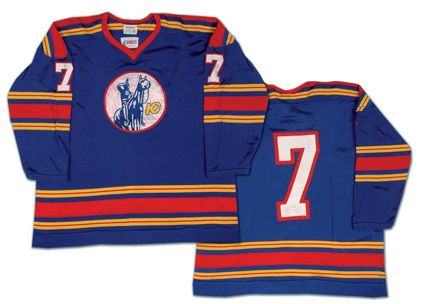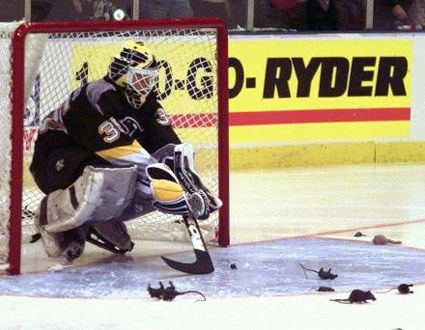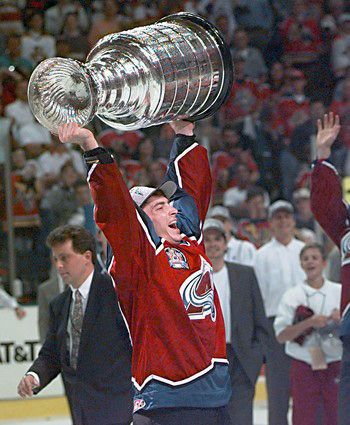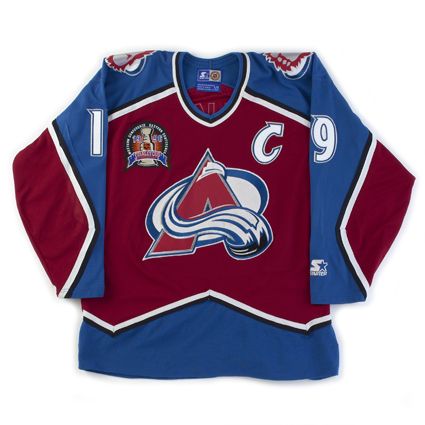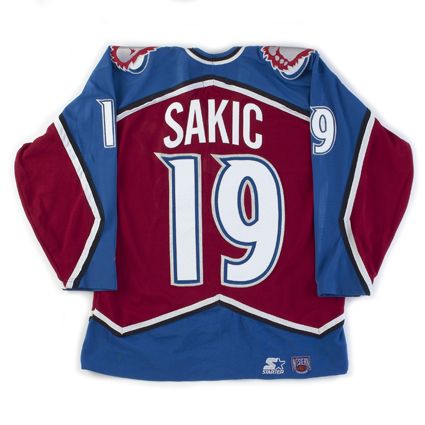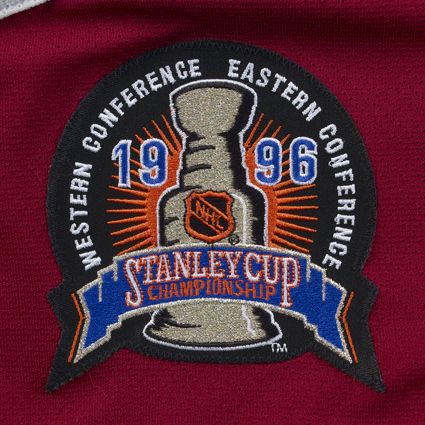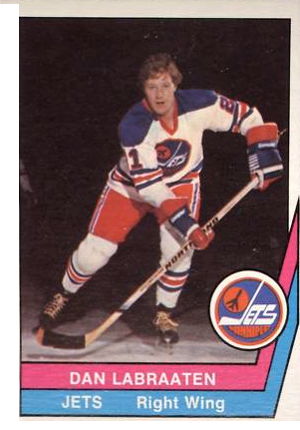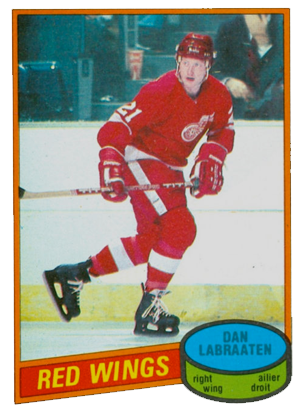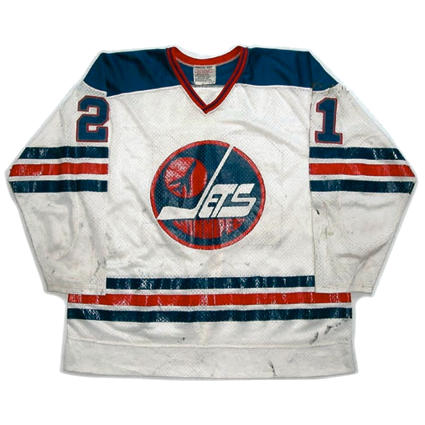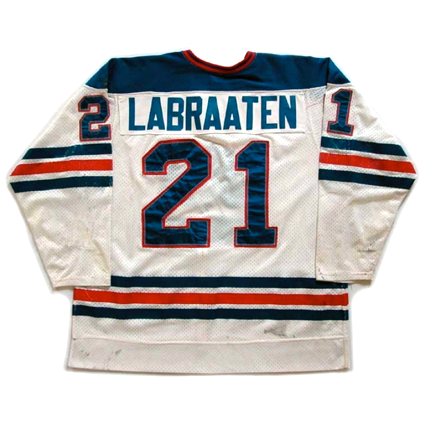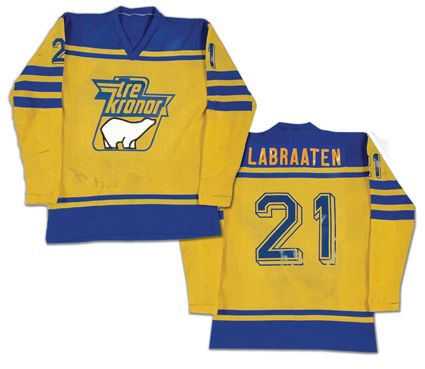Friday, June 13, 2014
1978-79 Edmonton Oilers Garnet "Ace" Bailey Jersey
Garnet "Ace" Bailey, born on this date in 1948, first played for the Edmonton Oil Kings in junior hockey from 1964 to 1967, including a Memorial Cup championship in 1966.
He was drafted by the Boston Bruins in the 1966 NHL Amateur draft with the 13th overall pick and started his professional career with the Oklahoma City Blazers of the Central Hockey League followed by further seasoning with the Bruins minor league Hershey Bears in the American Hockey League in the 1968-69 season where he had a nice season with 56 points in 60 games. Bailey excelled in the playoffs with 14 points in 9 games as Hersey won the Calder Cup as AHL champions. He also found the time to make his NHL debut with the Bruins, seeing action in eight games during which he scored his first NHL goal on his way to six points. He even got his first taste of NHL playoff action in one postseason game for Boston.
The 1969-70 season saw him crack the Bruins lineup, appearing in 58 regular season games. While Bailey did not suit up for any of the Bruins playoff games, that season (perhaps due to injury) his name was included among those engraved on the Stanley Cup following the Bruins championship, capped off by Bobby Orr's famous cup winning overtime goal in Game 4.
His next season was split between the Boston and Oklahoma City before finally establishing himself as a full-time NHL regular in 1971-72 when he skated in 73 games for the Bruins as well as 13 playoff games, including scoring the game winning goal in Game 1 of the 1972 Stanley Cup Finals versus the New York Rangers, as Bailey got his name on the Stanley Cup for the second time.
Bailey's next three seasons in the NHL were ones of change, as the Bruins traded him to the Red Wings after 57 games of the 1972-73 season. Half way through the next season, Detroit sent Bailey to the St. Louis Blues. Once more Bailey was on the trading block, when St. Louis dealt him to the Washington Capitals after 49 games of the 1974-75 season despite Bailey having already set a career high with 41 points in 49 games for the Blues. Combined with the 17 points he scored in 22 game for the Capitals, his 58 points would remain the best offensive output of his 10 years in the NHL.
Washington proved to be a good fit of Bailey, and he would see action in 67 games in 1975-76 and 78 the following year, his second highest scoring season with 46 points.
Bailey, who was known for his sense of humor once received a four-inch-manual from Capitals head coach Tom McVie, telling him how to get into condition. Bailey used the manual to prop up a beer keg in his bar. On the first day of training camp, according to theSan Francisco Chronicle, Bailey beat several other players in a footrace, and McVie said approvingly, "Ace, I can see you used your book this summer." Bailey replied, "Coach, I used it every day."
Another story relates how McVie once scheduled a practice for the squad at the ungodly hour of 4 AM. As the sleepy players arrived in their hotel lobby, Bailey, impersonating McVie, had already called and cancelled the bus scheduled to take them to the rink, which eventually led to the cancellation of the practice and some much needed additional sleep for the team.
After one more season in Washington, his fourth, Bailey's career would come full circle, as he would return to the scene of his junior hockey roots in Edmonton, this time with the Oilers of the WHA for 38 games where he would become a roommate and mentor a young Wayne Gretzky, becoming one of the few players to play with both Orr and Gretzky.
His playing days concluded with seven games with the CHL's Houston Apollos in 1979-80, before retiring to become their head coach, and a single game with the Wichita Wind of the CHL (while he was their head coach) in 1980-81.
His final NHL totals were 568 games played, 107 goals and 171 assists for 278 points.
Beginning in 1981, he worked as a scout for the Oilers from 1981 to 1994 and win five Stanley Cup rings during the Oilers dynasty from 1984 to 1990, which included his name engraved on the cup three of those times.
Sadly, while working as the director of pro scouting for the Los Angeles Kings, Bailey was a passenger on United Airlines Flight 175 which was crashed into the World Trade Center on September 11, 2001, killing all on board. The Ace Bailey Children's Foundation was established in his memory. To make a donation, simply follow this link.
Today's featured jersey is a 1978-79 Edmonton Oilers "Ace" Bailey jersey as worn during Bailey's only WHA season. The Oilers adopted this style jersey during their third WHA season of 1974-75 and used this version of the logo with the blue lettering on an orange background through their final WHA season of 1978-79. When the Oilers joined the NHL the following season, the logos on both the home and road jerseys were changed to blue letters on a white background, a higher contrast and much more pleasing combination.
Bonus Jersey: Today's bonus jersey is a Koho 2001-02 Los Angeles Kings Glen Murray jersey, which features the "AM" patch in memory of Ace Bailey and Mark Bavis, a fellow scout with the Kings who was also killed on board Flight 175 with Bailey. The jersey also is adorned with the 2002 NHL All-Star Game which was hosted by the Kings that season.
The Kings introduced this purple jersey as an alternate style to their white home and black road jerseys in 1999 and wore it for three seasons. At the time, the all the home jerseys in the NHL were branded as CCM, while the dark and alternate jerseys carried the Koho brand and the practice jerseys were tagged Jofa, as all three brands were part of the same company.
Later, in time for the 2002-03 season, the Kings flipped logos on their jerseys, making the crown logo seen here, the new primary logo for both their white and black jerseys, where it remains in use today, while the purple alternate jersey began to use the coat of arms logo (seen here on the shoulders as a secondary logo) through 2006-07 prior to the purple jersey being discontinued with the change to the new Reebok Edge jerseys, which dictated the temporary elimination of alternate jerseys.
Our first video today is a look at the Ace Bailey Got Skills program, created in Bailey's memory.
Our second video is from the Ace Bailey Children's Foundation.
Again, if you'd like to make a donation, simply click on the image below.
Labels:
Bailey Garnet Ace,
Edmonton Oilers
Wednesday, June 11, 2014
1940-41 Boston Bruins Bill Cowley Jersey
Bill Cowley, born on this date in 1912, won the scoring title in the Maritime Senior Hockey League in 1934 with 50 points in 28 games while playing for the Halifax Wolverines, giving notice as to what was to follow in the years to come.
Cowley then began his NHL career with the St. Louis Eagles during their one and only season after relocating from Ottawa. Following the demise of the Eagles, Cowley was claimed in a dispersal draft of the former St. Louis players by the Boston Bruins. Originally used as a left wing, Cowley was moved to center to take full advantage of his excellent play making abilities.
Beginning in the 1935-36 season, Cowley's point totals began a steady climb during the first four seasons of his career, first from 21 points to a team leading 35 followed by 39 points in a then 48 game season. Although limited to 34 games by injury, Cowley exceeded a point-per-game average in 1938-39 with 8 goals and 34 assists for 42 points in just 34 games to finish third overall in league scoring. He continued this pace in the playoffs with 14 points in 12 games as the Bruins won the 1939 Stanley Cup in five games over the Toronto Maple Leafs.
1939 OPC Bill Cowley hockey card
He again reached the 40 point mark the following year, but his streak of being the Bruins leading scorer ended at three. In 1940-41, Cowley then led not only the Bruins in scoring, but the entire NHL while setting a new league record of 62 points. Cowley's 45 assists alone were enough to win the scoring race, as his final point total was 40% more than his nearest challengers 44 points. While Cowley would only compete in two post-season games that season, the Bruins would win their second Stanley Cup in three seasons. At the conclusion of the season, Cowley was named the winner of the Hart Trophy.
After a short 28 game season in 1941-42, a healthy Cowley returned in 1942-43 to again lead the Bruins in scoring and set a new personal best in the process with 27 goals and 45 assists for 72 points, just one behind Chicago's Doug Bentley's new league record of 73 points. 8 more points followed in 9 playoff games as the Bruins again returned to the Stanley Cup Finals and Cowley was awarded his second Hart Trophy.
In 1943-44 Cowely had what would have been the most remarkable seasons in NHL history up to that point turn into a virtually forgotten footnote instantaneously. Cowley, who was on pace to shatter the league scoring record with 95 points, had reached 71 points and was averaging an amazing 1.97 points per game when an injury ended his season with 12 games remaining, which at the time was 25% of the schedule. Despite being limited to 36 games, Cowley's 30 goals that season would prove to be a career high.
Bill Cowley #10, centering a line for the Bruins
He returned with 65 points to lead the Bruins in scoring for the sixth time in 1944-45. He only completed in 26 games in 1945-46, but was healthy in time for the playoffs as the Bruins made another appearance in the finals. His final NHL season, his 12th with the Bruins, saw him score 38 points to finish his career as the NHL's all-time leading scorer with 548 points, scored in 549 games. He was also the last active player from the St. Louis Eagles roster.
Cowley was inducted into the Hockey Hall of Fame in 1968, the only Hall of Famer to begin his career with the St. Louis Eagles.
Today's featured jersey is a 1940-41 Boston Bruins Bill Cowley jersey from the season Cowley set a new league record with 62 points while winning the scoring title. The Bruins introduced this gold alternate jersey, as opposed to a full time road jersey, in 1940-41 and went on to win the Stanley Cup with a four game sweep of the Detroit Red Wings that year.
This gold jersey was worn for four seasons until being retired after the 1943-44 season. Prior to the introduction of today's jersey, the Bruins wore a single jersey style for both home and road games all season long, dating back to their first season of 1924-25.
Labels:
Boston Bruins,
Cowley Bill
1974-75 Kansas City Scouts Guy Charron Jersey
In 1972, the World Hockey Association came into being, competing directly with the NHL for players and franchise locations. The NHL had already added the Atlanta Flames and New York Islanders in 1972, with the Islanders in particular being a deliberate expansion to occupy a location viewed as desirable by the WHA.
With the WHA having placed teams in direct competition with the NHL in Philadelphia, Boston, Los Angeles, New York, Minnesota and Chicago and taken smaller Canadian markets like Edmonton, Ottawa, Quebec and Winnipeg as their own, the competition for cities in the United States was where the NHL could use expansion as a weapon in their fight against the upstarts.
The remaining cities occupied by the WHA in 1972 were Cleveland and Houston, rounding out their original roster of 12 teams. The weak links in the WHA proved to be Philadelphia, New York and Ottawa, despite their having no direct rival in the NHL. The Philadelphia Blazers moved across the continent to take on the Canucks in Vancouver, while the New York Raiders changed owners and their name to the Golden Blades before fleeing Manhattan to become the New Jersey Knights in what was actually a suburb of Philadelphia 90 miles down the Jersey Turnpike. There, they fared even worse than the Blazers, while playing in a laughably substandard home rink.
Meanwhile, Ottawa learned absolutely nothing from the Raiders/Golden Blades about life as tenant of an NHL franchise and made the genius move to have cantankerous NHL hardliner Harold Ballard of all people become their landlord when they moved into Maple Leaf Gardens in Toronto to become the Toros!
That set the scene for the 1974-75 season. The WHA made the questionable move to add teams in Indianapolis and Phoenix as well as having the New Jersey (Philadlephia) franchise set up shop in San Diego, which suffered from the loss of it's potential rivalry with Los Angeles when the Sharks were the next team to try to go head to head with an established NHL cornerstone in Detroit when they became the Michigan Stags, lasting less than a full season.
As a countermove, the NHL expanded to occupy what it viewed as key markets, and on this date in 1974, franchises were awarded to Washington D. C. and Kansas City.
The Kansas City market had been home to a number of teams, dating back to the mid 1920's, including the Kansas City Pla-Mors of the American Hockey Association. They changed their name to the Kansas City Greyhounds in 1933 and the Americans in 1940, lasting until 1942. Other teams played in the United States Hockey League from 1945 to 1951 and the Central Hockey League from 1967 to 1972.
The Kansas City Scouts were to call the brand new Kemper Arena home and it was hoped that they would create a rivalry with their fellow Missouri residents, the St. Louis Blues. The club was originally going to be called the Mohawks, taking "Mo" from the postal abbreviation for Missouri, and "hawks" from the Kansas nickname of "Jayhawkers" in an effort to appeal to residents on both sides of the border, but the established Chicago Black Hawks protested, saying the name sounded too similar to theirs.
Thus, a name the team contest was held, which resulted in the Scouts being chosen in honor of an iconic statue named "The Scout" which overlooks downtown Kansas City from a hill in a nearby park.
The club formed their roster as best they could under the rules the expansion teams were forced to deal with, combined with the intense competition from an additional 14 WHA teams. The Scouts chose goaltender Michel Plasse, a former player with the Kansas City Blues, with their first choice in the 1974 NHL Expansion Draft. Peter McDuffe, another goaltender was chosen second and winger Simon Nolet was taken from the Philadelphia Flyers and would go on to lead the team in scoring.
Simon Nolet
The Scouts would pick second in the Amateur Draft, and chose well, taking eventual NHL All-Star Wilf Paiement. Things did not go quite so well after that, with second round pick Glen Burdon playing a total of 11 NHL games and eventual All-Star and four time Stanley Cup champion Bob Bourne, taken in the third round, being traded for Bart Crashley (2 games with the Scouts) and the rights to Larry Hornung, who played the rest of his career in the WHA, before Bourne ever played a game in Kansas City.
Wilf Paiement
Their first season began with eight games on the road to allow final completion of Kemper Arena. The brutal road trip was a dreadful way to begin life for an expansion club, as they immediately lost 7 and tied 1. After a loss in their home opener on November 2, 1974 to the Chicago Black Hawks, the Scouts finally won their first game over their expansion brothers, the Washington Capitals in Washington.
They would reach New Year's Day with a 5-26-4 record and play respectable hockey through January and February, going 9-13-4, before limping home 1-14-3 to finish next to last with 41 points, 10 back of the lowly California Seals, but 20 ahead of the moribund Capitals.
Nolet led the club in goals with 26 and assists with 32 for 58 points. Guy Charron, obtained from Detroit, was next with 42 points, while Paiement tied Nolet for the lead in goals with 26 of his own on his way to fourth, with his 39 points 2 back of Dave Hudson's 41.
In goal, Plasse lasted 24 games before packing his bags after being traded to Pittsburgh for Denis Herron, who played 22 games while McDuffe led the club in wins with 7 in 36 appearances.
Peter McDuffe
Attendance was essentially the same story, as the Scouts finished 17 out of 18 at 7,356, ahead of the Seals 6,172, the only two clubs under 10,000.
The Scouts second draft was nothing short of a failure, failing to land a single player who would play even 170 NHL games as they passed on players like Dennis Maruk, Doug Jarvis and Dave Taylor in what would prove to be an extraordinarily shallow draft that would produce just 6 All-Stars out of 217 picks.
The 1975-76 season began well enough with a 3-2-1 record before the losses began to outnumber the wins. As the calendar reached New Year's, the Scouts were 11-22-4 and on pace for 58 points, but the second half of the season was an unqualified disaster, commencing with a 14 game losing streak.
Two ties, a win and a tie gave a false flicker of hope, as the team went 0-21-6 after their final win on February 6th, their only victory in 1976.
The roster was somewhat of a revolving door, which saw a number of trades, with seven players leaving (along with a first and a pair of second round draft picks) and nine coming in, with one draft pick coming back.
Among those leaving was first year leading scorer and team captain Nolet, who was sent east to Pittsburgh. Charron, now promoted to captain, led the team with 27 goals and 44 assists for 71 points, far ahead of Paiement's 43, the only other player over 40. Also of note, Steve Durbano became a fan favorite as he led the league in penalty minutes with 209. There was turnover in goal as well, as McDuffe was out, which allowed Herron to play 64 games (winning 11), backed up by Bill McKenzie's 22, only one of which he won.
Denis Herron
During their first two seasons, the Scouts had two head coaches Bep Guidolin and Eddie Bush, three if you count Sid Abel's three game stint to bridge the gap when Guidolin was let go during the Scouts second season.
While attendance technically rose to 7,892, it still remained 17th. With the team suffering from a rapid rise in player costs, an ownership group (of thirty-seven individuals!) in debt and losing money and poor play on top of the poor attendance, 5,000 below the league average, the ownership gave it one final chance, but when a season ticket drive to raise more cash sold only 2,000 tickets, the group sold the team to interests who would immediately relocate the franchise to Denver, Colorado for the 1976-77 season, where it was renamed the Colorado Rockies, brining to and end the Scouts stay in Kansas City after an all-to-brief two seasons.
Today's featured jersey is a 1974-75 Kansas City Scouts Guy Charron jersey from the Scouts first season of play. Charron would go on to lead the Scouts in scoring not only in their second season of play, but would lead the franchise in scoring during their time in Kansas City as well.
Charron began his career in 1969-70 with the Montreal Canadiens before five seasons with Detroit before being traded to the Scouts. He would not move with the team to Denver, instead moving over to the Capitals for the final five seasons of his NHL career, which totaled 734 games.
Playing only two seasons in Kansas City did not leave much time for jersey variations, but their second season saw a yellow outline added to the crest to help it separate from the blue background better and the white home jerseys had names added during their second and final season.
photo courtesy of Classic Auctions
Today's video segment is Kansas City taking on the Chicago Black Hawks, which includes Paiement scoring the first goal at home for the Scouts franchise, with the second half of the video being against the Minnesota North Stars.
Labels:
Charron Guy,
Kansas City Scouts
Tuesday, June 10, 2014
1995-96 Colorado Avalanche Joe Sakic Jersey
With the financial troubles of the Quebec Nordiques mounting, they found it difficult to compete with rising player salaries, made even more difficult by a weakening Canadian dollar. Playing in by far the smallest market in the NHL, plus the language barrier facing potential free agents, unlike bi-lingual Montreal, Quebec City was virtually all French, the team owner asked for a bailout from the Quebec government, but was turned down. The team was subsequently sold to a group of investors from Denver, Colorado, where the team was moved and renamed the Colorado Avalanche.
The fans in Colorado were immediately handed a team stocked with captain Joe Sakic, Valeri Kamensky, Adam Deadmarsh, Mike Ricci, Adam Foote and Peter Forsberg. The team later added Claude Lemieux just days before the start of the season and Sandis Ozolinsh later in October.
If that weren't enough, former Montreal Canadiens captain Mike Keane and no less than Patrick Roy arrived in early December after Roy had a public falling out with the Canadiens organization, a trade that never would have happened had the franchise remained in Quebec as the Nordiques, the Canadiens bitter province rivals.
With Roy now anchoring the team in goal, they finished with a 47-25-10 record, easily winning the Pacific Division by 25 points. They defeated the Vancouver Canucks, Chicago Blackhawks and President's Trophy winning Detroit Red Wings, all by identical 4 games to 2 margins. The series against the Red Wings would kick off one of the greatest NHL rivalries, as the teams would meet in the playoff five times in seven years, with three of those being for the right to go to the finals, plus several memorable regular season brawls - which included the goaltenders! The rivalry has even been chronicled in book "Blood Feud", which can be purchased here.
The Florida Panthers would be the opponent for the Avalanche in the Stanley Cup finals, which would open in Denver. Colorado conceded the first goal in Game 1 but three goals in a five minute span of the second period would turn the game in favor of the Avalanche.
Game 2 was tied at 1-1 after eight minutes, but from then on it was all Colorado as they powered to a decisive 8-1 win as the series moved to Florida.

Game 3 in Florida saw Lemieux return from a suspension to score the first goal of the game but Ray Sheppard equalized for Florida at 9:14 and the rats rained down. The Panthers then took the lead on Rob Niedermayer's goal at 11:19 and again thousands of rats pelted ice and Roy, who was unable to escape to the safety of the bench. Following the conclusion of the first period Roy made a resolute declaration - "No more rats".
The quick-strike Avalanche needed just 1:38 into the second period to tie the game on Keane's goal before Sakic got the game winner just 1:22 later as Roy held Florida scoreless the rest of the way for a commanding 3-0 series lead.
The final game, played on this date in 1996, would be legendary. With their lives on the line, Vanbiesbrouck would match Roy save for save as the game progressed through a scoreless first period and then a second. The third period also could not produce a winner and regulation ended deadlocked at 0-0.
Colorado put on the pressure in the first overtime, outshooting Florida 11-7 but Vanbiesbrouck did not bend. The Panthers turned the tables in the second overtime 18-12 but failed to solve Roy to send the game to it's third extra period. Finally, Uwe Krupp won the cup with the cup winning goal at 4:31 for a 1-0 victory for the Avalanche. True enough, Roy kept his promise, holding Florida scoreless for over seven periods of play following his declaration following the first period of Game 3. His streak included 18 saves for the remainder of Game 3 and 63 saves in Game 4 for a total of 81 shots and no goals and no more rats.
Game 2 was tied at 1-1 after eight minutes, but from then on it was all Colorado as they powered to a decisive 8-1 win as the series moved to Florida.
One of the lasting memories of that year's playoffs were the Panthers fan's celebratory rats, which would rain down on the ice by the thousands for each Florida goal, causing opposing goalies to seek shelter inside their net until the hailstorm subsided.
The celebration stemmed from captain Scott Mellanby deftly killing a rat with a one-timer in the dressing room prior to the team's opening game of the season. When he followed it up by going out and scoring two goals that night, goaltender John Vanbiesbrouck dubbed the feat "a rat trick".

Game 3 in Florida saw Lemieux return from a suspension to score the first goal of the game but Ray Sheppard equalized for Florida at 9:14 and the rats rained down. The Panthers then took the lead on Rob Niedermayer's goal at 11:19 and again thousands of rats pelted ice and Roy, who was unable to escape to the safety of the bench. Following the conclusion of the first period Roy made a resolute declaration - "No more rats".
The quick-strike Avalanche needed just 1:38 into the second period to tie the game on Keane's goal before Sakic got the game winner just 1:22 later as Roy held Florida scoreless the rest of the way for a commanding 3-0 series lead.
The final game, played on this date in 1996, would be legendary. With their lives on the line, Vanbiesbrouck would match Roy save for save as the game progressed through a scoreless first period and then a second. The third period also could not produce a winner and regulation ended deadlocked at 0-0.
Colorado put on the pressure in the first overtime, outshooting Florida 11-7 but Vanbiesbrouck did not bend. The Panthers turned the tables in the second overtime 18-12 but failed to solve Roy to send the game to it's third extra period. Finally, Uwe Krupp won the cup with the cup winning goal at 4:31 for a 1-0 victory for the Avalanche. True enough, Roy kept his promise, holding Florida scoreless for over seven periods of play following his declaration following the first period of Game 3. His streak included 18 saves for the remainder of Game 3 and 63 saves in Game 4 for a total of 81 shots and no goals and no more rats.
With the Stanley Cup win, Russians Alexi Gusarov and Kamensky and Swede Forsberg became members of the exclusive Triple Gold Club for players who have won Olympic Gold, World Championship Gold and the Stanley Cup.
Today's featured jersey is a 1995-96 Joe Sakic Colorado Avalanche jersey with the 1996 Stanley Cup finals patch as worn by Joe when he was awarded the Conn Smythe Trophy. following his 18 goals and 34 points in the playoffs.
When the Avalanche landed in Colorado, the adopted an entirely new identity, from the singular team name, unique to the NHL colors and ground breaking jerseys, which featured the unusual striping pattern reminiscent of a mountain range.
When the Avalanche landed in Colorado, the adopted an entirely new identity, from the singular team name, unique to the NHL colors and ground breaking jerseys, which featured the unusual striping pattern reminiscent of a mountain range.
The Stanley Cup finals patch was the first of many that the Avalanche would wear with this style jersey, that would remain unchanged through the 2006-07 season.
The Stanley Cup was the first major championship for a team located in Denver, no doubt leaving the fans left behind in Quebec City to look on in yearning. The Cup was the second for a team that originated in the World Hockey Association, with the first being the Edmonton Oilers.
Labels:
Colorado Avalanche,
Sakic Joe
Monday, June 9, 2014
1976-77 Winnipeg Jets Dan Labraaten Jersey
Swedish left winger Dan Labraaten, born on this date in 1951, played in the Swedish second division for three seasons from 1966-67 to 1968-69.
He moved up to to the top level of Swedish hockey when he joined Leksands IF. During that time period he also skated for Sweden in the European Junior Championships in both 1968 (winning bronze), 1969 (silver) and 1970.
Labraaten continued to skate for the dominant Leksands IF over the course of the next six seasons, with his standout being the 1974-75 season in which he scored 24 goals and 38 points in 30 games while playing with future Minnesota North Stars Per-Olav Brasar and Roland Eriksson.
During Labraaten's time with the Leksands IF from 1970 to 1976, the team were playoff runners up in 1971 and 1972 and winners of the Le Mat Trophy as playoff champions in 1973, 1974 and 1975. Labraaten played for the Sweden National Team at the 1974 World Championships where he came away with a bronze medal.
He also added to his international resume with two more appearances in the World Championships, first in 1975 when he scored nine goals in ten games, and again in 1976 with eight points in ten games, coming home again with bronze medals both times. In September of 1976, Labraaten was a member of the Sweden National Team in the inaugural Canada Cup.
Following the success of Swedish imports Ulf Nilsson and Anders Hedberg, Labraaten joined the Swedish superstars as a member of the high flying Winnipeg Jets of the World Hockey Association for the 1976-77 season. While his 51 points were far and away his career high to date, thanks to a much longer season than in Sweden, it paled in comparison to to the 131 by Hedberg. The playoffs were another matter, as Labraaten was third in team scoring with 24 points in 20 games, just five back of Hedberg and three behind Nilsson but two ahead of the great Bobby Hull.
His second season in Winnipeg proved to be less personally successful, as he was limited to just 47 games, which naturally lowered his final offensive numbers to 34 points, but the Jets would capture the Avco Cup as league champions at the end of the season.
He was not retained by the Jets and signed with the Detroit Red Wings of the NHL for the 1979-80 season. The going was a bit tougher in the NHL, as Detroit was going through the "Dead Wings" era, during which they missed the playoffs 15 of 17 seasons. Despite playing in 31 more games with Detroit, he only scored four more points than he did in with Winnipeg, a reflection of playing with a losing team in a less wide open league. With Detroit missing the playoffs yet again, Labraaten was available for World Championship duty for Sweden in 1979, which resulted in his fourth bronze medal in as many tries.
Labraaten then had the best season of his career, setting career highs with 30 goals and 57 points in 1979-80. A poor first half in 1980-81 saw the Red Wings trade him to the Calgary Flames where he was strictly a role player over the next season and a half during which he played in just 70 games and scoring 38 points to close out the NHL portion of his career.
Labraaten returned to Sweden for the 1982-83 season and rejoined Leksands IF, with whom he would play the final six seasons of his professional career. Proving he had not lost his offensive touch, Labraaten had the finest season in Sweden during 1983-84 during which he score 23 goals and 44 points in 36 games to win the Elitserien scoring championship. He had one final 20 goal season in 1985-86.
He also made two more World Championship appearances, the first in 1985 and a final one in 1986 which earned Labraaten a long awaited silver medal to go with his four bronzes.
His combined totals across three leagues and his many international appearances are 786 games, 340 goals and 627 points as well as a fist full of World Championship medals.
Today's featured jersey is a 1976-77 Winnipeg Jets Dan Labraaten jersey as worn during his first season of hockey in North America.
The Jets adopted this style for their second WHA season of 1973-74 and used it throughout the remainder of their six seasons in the WHA. Upon entry into the NHL in 1979-80, they celebrated with a new set of sweaters, retiring their WHA era jerseys which had seen them through three championship seasons.
Bonus Jersey: Today's bonus jersey is a 1979 Sweden National Team Dan Labraaten jersey. This jersey is from a unique period of Swedish hockey in the late 1970's and early 80's when Sweden did not wear their famous three crowns logo which is most closely associated with Swedish hockey, but opted instead for a polar bear crest below the words "tre kronor", Swedish for "three crowns".
Labels:
Labraaten Dan,
Sweden,
Winnipeg Jets
Subscribe to:
Posts (Atom)


